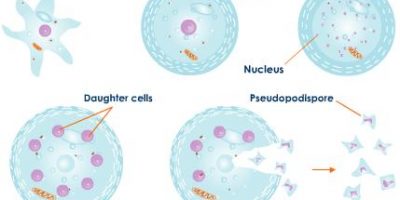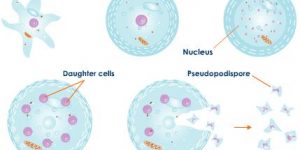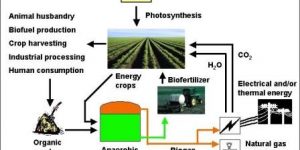CUTTING
In cutting, a piece of root, stem, leaf or a bud is set in the soil to grow and become a new plant. This piece of plant then grows descending roots and aerial organs that appear in the external environment. This procedure is beneficial for large scale production which is cost reducing, valuable and worthwhile.
BUDDING
Budding is found in both unicellular as well as multicellular organisms. In unicellular organisms, because of the arrangement of nucleus and cytoplasm within single-celled organisms, some parts of the body bulge out as a bud at any point and grow into a complete organism. This organism acts freely after disconnecting from the mother cell. Occasionally, […]
Fission and Its Types : Binary Fission and Multiple Fission

Fission takes place in single celled organisms. It is further divided into two types binary fission and multiple fission. 1- BINARY FISSION In binary fission two single celled organisms are produced through mitotic division. In this process, the nucleus and cytoplasm are divided as well, which results in two single celled organisms that are identical […]
Bleaching Powder
Bleaching powder is a white solid powder containing a mixture of calcium hydroxide, calcium chlorate (I) and calcium chloride. It is manufactured by Hasenclever method on a huge quantity by passing the chlorine gas over a solution of calcium hydroxide.
CEMENT
Cement is a soft, smooth substance usually present in powder form. It is composed of different elements that are found naturally such as limestone, clay and sand. When combined with water, it binds sand and gravel into a hard solid mass known as concrete. Joseph Aspidin of England discovers it in 1824.The original name of […]
What is Grafting?
Grafting involves joining together of two parts from different plants. These parts come in close contact, join mutually and grow as a one plant afterwards. Some part of a fully grown or developed plant is attached to a part of a young plant. This results in an early flowering in the latter. Part of plant […]
Plaster of Paris
The chemical name of Plaster of Paris is Calcium Sulphate Hemihydrate. Since it is formed by using Gypsum (colorless minerals) which is mostly found in Paris that is why it is called Plaster of Paris. Representation of a substance plaster of Paris using symbols is CaSO4.1/2 H2O while its chemical formula is written as (CaSO4)2.H2O.
Uses of Artificial Satellite
There are many uses or artificial satellites. In communication field, they are used for telecommunication, TV transmitter, radio networks, and internet. In educational field, they are used for teleconferencing and nationwide classrooms. In weather forecasting, artificial satellites are used to get reports about monsoon, cyclones, changes of climate, etc. In oceanography, they are used to […]
Orbits of Artificial Satellite
Artificial satellites orbits in either Equatorial or Artificial or Polar orbits. Equatorial orbit is the orbit being parallel to the equator. In equatorial orbits, satellites do not need energy for revolutions. To make a satellite appearing stationary in space when viewed from the Earth, or called Geostationary, a satellite should be placed at about 35,786 […]
Artificial Satellite
Any human-built objects that move orbiting the Earth and other planets in Solar System are called artificial satellite. They are not natural satellites, or what we called moons, that move naturally orbiting planets, dwarf planets, or asteroids. Artificial satellites are built in many purposes; studying Earth and other planets, studying universe, or communicative satellites. Some […]


